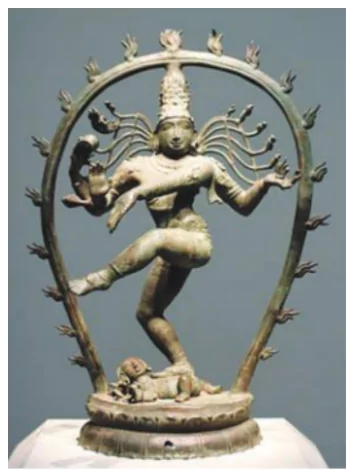Medieval sculptures, spanning from the 5th to the 15th century, depict a diverse range of religious, cultural, and political themes, reflecting the artistic evolution and socio-historical contexts of the era.
Different Medieval Sculptures
- Pallavas: An artistic movement of great importance flourished under the aegis of the Pallava rulers of Kanchi.
- Some of the sculptures include Seven monolithic Rathas in Mahabalipuram, Mahishasuramardini in relief, Girigovardhana panel, Arjuna’s penance or the Descent of the Ganga, Trivikrama Vishnu, Gajalakshmi, Anatasayanam and great goddess Durga engaged in a fierce battle with the Buffalo headed demon.
- The Pallava period also holds a rich Bronze sculpture tradition like the bronze sculpture of Shiva in Ardhaparyanka asana (one leg kept dangling).
- Cholas: They succeeded the Pallavas and ruled over South India from the 9th to 13th centuries AD.
-
- Chola Medieval sculptures were present at Brihadeesvara temple in Tanjavur.
- Other sculptures: 11th-century relief carving of Siva as Gajsurasamahamurti, and 13th-century sculpture showing Bhudevi or the earth goddess as the younger consort of Vishnu.
- Cholas have a rich tradition of bronze sculptures, and Chola Queen Sembiyan Mahadevi was a distinguished patron.
| Nataraja Sculpture

- It is a bronze sculpture of Chola period showing Lord Shiva balancing himself on his right leg and suppressing the Apasmara, the demon of ignorance, with the foot of the same leg.
- He raises his left leg in Bhujangatrasita stance, which represents Tirobhava, which is kicking away the veil of Maya or illusion from the devotee’s mind.
- His four arms are outstretched, and the main right hand is posed in Abhaya hasta while the upper right holds Damaru.
- The upper left-hand carries a flame while the main left hand is held in Dola hasta and connects with the Abhaya hasta of the right hand.
- His hair locks fly on both sides, touching the circular Jvala mala or the garland of flames.
|
- Rashtrakutas: In the middle of the 8th century, the Rashtrakutas wrested power from the Chalukyas.
- Their Medieval sculptures include images of Shiva marrying Parvati, Ravana shaking Mount Kailasa, Dasavatara Bhirava, dancing Shiva and Vishnu at the Kailasa temple in Ellora. (The temple was built by King Krishna I)
- Elephanta Caves: Medieval Sculptures include Nataraja, Sadashiva, Ardhanarishvara and Maheshamurti
- Maheshamurti has three heads emanating from one – The central head is the main Shiva figure, and the other two are Bhairava & Uma, representing three different aspects of Lord Shiva.
Enroll now for UPSC Online Course
- Chandellas: They ruled from 950 to 1100 AD and constructed towering temples in central India.
- They constructed temples like Kandariya Mahadev temple at Khajuraho.
- It was sculpted with human representations with slender taller figures and a considerable accentuation of linear details.
- Palas and Sena:
- The Pala rulers in Bihar and Bengal were Buddhists by faith and greatly encouraged centres of learning like Nalanda and Vikramasila, where the stupas and monasteries gave ample scope for development of Medieval sculptures.
- Among the bronze sculptures is a four armed Avalokiteswara in graceful tribhanga posture.
- Figure of river goddess Ganga from Mahanad in West Bengal.
- The Pala tradition continued under the Sena rulers in the 12th century until the Islamic rulers overran the country.
- Eastern Ganga Dynasty: They ruled Odisha from the 7th to the 13th century. Their sculptures maintained the traditional lines of grace and vigour.
- The Orissan temples have many beautiful female figures called Nayikas.
- Sculptures can be found on the walls of temples at Bhubaneswar, Puri and Konark.
Sun Temple at Konark
- It was built by Narasimhavarman in the middle of the 12th century and dedicated to the sun god. It has been conceived as a huge stone chariot on immense wheels, dragged by seven horses.
- On the plinth of the Jagmohana of the temple, are installed celestial musicians facing in all directions, playing on different musical instruments.
|
- Hoysala: They ruled in the Mysore region at the beginning of the 12th century.
- The decoration was elaborate. The emphasis was more on ornamentation than movement or the grace of the human body.
- Sculptures were squat, short and highly embellished.
- Examples: Temples at Halebid and Belur where sculpture looks like lacework in stone. The carving of Lord Krishna holding aloft the mountain Goverdhana is another example.
- Vijayanagara: They ruled from 1336 to 1565 AD and continued the Chola and Chalukyan art traditions.
- They built temples at places like Tadpatri, Hampi, Kanchipuram etc and carving in these temples indicates their sculptural skills.
- Narrative forms of the Ramayana and Krishna Bal Lila were their favourite themes.
- Vijayanagara rulers also made the sculptors carve excellent portraits of themselves, like the Portrait of Krishnadevaraya at Chidambaram temple and life-size bronze statues of Krishnadevaraya and his Queens at Tirupati.
- Many sculptures were carved in the Gopura and courts of Meenakshi temple at Madurai during Krishnadevaraya’s reign.
- Nayakas of Madurai and Tanjavur: Animal motifs attained importance, and they are carved with details. Examples include the sculptures at Srirangam temple in Trichinapally.
Enroll now for UPSC Online Classes
Conclusion
- Medieval sculptures offer glimpses into the spiritual, social, and artistic landscapes of their time, contributing to a deeper understanding of medieval history and culture.
![]() April 12, 2024
April 12, 2024
![]() 916
916
![]() 0
0